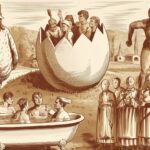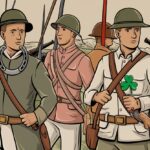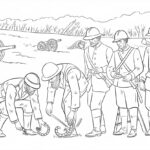The Creation of “Army Instructional Comics” for Troop Education
When most people think of World War II training, they picture boot camps, field manuals, and grizzled sergeants barking orders—not comic books. And yet, in one of the war’s most fascinating and unconventional educational pivots, the U.S. military turned to comics as a serious tool for troop instruction. Faced with the challenge of rapidly educating millions of young men—many of whom had limited formal schooling—the Army realized that visual storytelling could cut through complexity faster than any chalkboard lecture or technical manual ever could.

At the center of this innovation was Will Eisner, a pioneering comic artist best known for creating The Spirit. Drafted into the Army in the early 1940s, Eisner was assigned to the publication Army Motors, where he began crafting what would become known as “Army Instructional Comics.” His most memorable creation, a bumbling character named Joe Dope, embodied the “what-not-to-do” approach. Joe’s exaggerated failures—like over-lubricating a rifle or ignoring safety protocols—were both hilarious and educational, making mistakes memorable without putting real soldiers at risk.
This wasn’t just slapstick for the sake of entertainment. These comics tackled essential topics like weapon maintenance, hygiene, and vehicle care, often distilling dense technical procedures into digestible panels that could be understood at a glance. Eisner emphasized clarity over complexity, using humor and caricature to ensure that even soldiers with minimal literacy could grasp key concepts. As he later reflected, “The graphic narrative was the best way to communicate with a semi-literate audience”.
The Army wasn’t alone in this strategy. The Navy and Air Force also commissioned comics, enlisting a star-studded lineup of artists including Dr. Seuss (Theodor Geisel), Al Capp, and Robert Osborn. Osborn’s character “Dilbert Groundloop,” for example, was used to warn pilots about reckless flying—an issue known as “flat hatting.” Meanwhile, the Navy’s Bureau of Medicine and Surgery produced illustrated posters and comics addressing public health dangers like malaria and venereal disease, turning serious medical warnings into vivid, unforgettable imagery.
The impact was profound. Between 1941 and 1944, comic book sales in military exchanges doubled from 10 million to 20 million copies per month, and much of that surge came from soldiers hungry for both entertainment and education. Instructional comics weren’t just tolerated—they were devoured. They became a staple in barracks and field tents, often passed from hand to hand until dog-eared and grease-stained.
In hindsight, this experiment in illustrated instruction wasn’t just a wartime improvisation—it was a revolution in military pedagogy. By blending humor, art, and practical know-how, the Army Instructional Comics transformed how knowledge was delivered to the front lines. And in doing so, they laid the foundation for the use of visual media in education long after the last shots of WWII were fired.
Simplifying Complex Topics Like Weapon Maintenance and First Aid
For many Americans drafted into World War II, the battlefield wasn’t the only unfamiliar terrain—they also had to navigate a flood of technical military knowledge, often with little formal education to support them. By 1942, it was estimated that nearly 70% of enlisted men hadn’t completed high school, and a significant number had education levels below the fourth grade. So how do you teach someone with limited literacy how to clean a Browning Automatic Rifle or treat a sucking chest wound under fire? The answer, surprisingly, was comic books.
The U.S. military turned to illustrated storytelling as a workaround for dense technical manuals, and it worked. Comics like those created by Will Eisner—featuring the hapless yet endearing “Joe Dope”—broke down complicated procedures into step-by-step visual narratives. Joe, often seen bungling a task in the pages of Army Motors, wasn’t just comic relief—he was a pedagogical tool. Through his errors, soldiers learned how to avoid costly mistakes in weapon maintenance and vehicle repair. The humor made it stick; the visuals made it clear.

First aid was another critical domain tackled through comics. These training materials used sequential art to demonstrate how to apply tourniquets, stop bleeding, or manage shock—essential battlefield skills that could mean the difference between life and death. According to the Pritzker Military Museum’s exhibit “Don’t Be a Dope!”, these comics were often printed on higher-quality paper to survive field conditions and were small enough to fit into a uniform pocket for quick reference.
Even Disney got involved. The studio produced animated and printed instructional materials on aircraft maintenance, blending entertainment with technical precision. The result? Soldiers stayed engaged, remembered more, and performed better—even under pressure. What could’ve been a dry, forgettable lesson became a vivid, memorable story. In the end, comics didn’t just entertain—they saved lives.
Characters Like “Private Snafu” Teaching Through Humor and Mistakes
If you were a young American soldier in 1943—fresh off the bus, boots barely broken in—you might have met your first military instructor not in a uniform, but in a cartoon reel. His name? Private Snafu. Clumsy, lazy, and perpetually unlucky, Snafu wasn’t your typical war hero. But that was exactly the point. Created by Frank Capra and brought to life by some of the brightest minds in animation—Chuck Jones, Friz Freleng, and even Theodor Geisel (yes, Dr. Seuss)—Private Snafu was designed to show soldiers what not to do, all while making them laugh.
The character’s name itself came from the military slang acronym “SNAFU,” short for “Situation Normal: All Fouled Up.” And fouled up he was. In each of the 26 shorts produced between 1943 and 1945 by Warner Bros., Snafu made a critical error—leaving classified documents lying around, failing to take malaria pills, or mishandling equipment—only to suffer the consequences in exaggerated, cartoonish fashion. These four-minute films, voiced by Mel Blanc (the iconic voice of Bugs Bunny), were uncensored, peppered with adult humor and mild profanity. Because they were intended for internal military use, they didn’t have to abide by the stricter Motion Picture Production Code.
What made Private Snafu so effective wasn’t just the humor—it was the relatability. Designed for draftees with varying levels of education, the cartoons distilled complex military protocols into memorable, bite-sized lessons. And they stuck. According to the Pritzker Military Museum’s exhibit, similar instructional characters like Joe Dope and Dilbert Groundloop reinforced technical procedures and safety practices through visual storytelling. Will Eisner, another comic legend, later expanded the format in “PS Magazine,” a postwar publication that continued using illustrated characters to teach equipment maintenance and logistics.
In an era before PowerPoint and online modules, Private Snafu was the military’s answer to the question: How do you teach thousands of young men—fast—without putting them to sleep? The answer, it turns out, was to make them laugh at someone who looked a lot like themselves, only a little more clueless.
How Comics Helped Soldiers Understand Cultural Sensitivity and Strategy
When we think of World War II training materials, we often imagine dry field manuals or drill sergeants barking orders—not colorful comic books packed with cartoon characters and speech bubbles. And yet, that’s exactly what thousands of American soldiers used to prepare for deployment abroad. In a war fought across continents and cultures, understanding local customs and strategic nuance wasn’t just helpful—it could mean the difference between success and failure. That’s where comics came in, offering more than just entertainment: they became tools for cultural instruction and strategic briefings.
During the 1940s, the U.S. military recognized that many of its recruits had limited formal education, making traditional instruction less effective. Comics, with their visual storytelling and accessible language, bridged that gap. According to the Pritzker Military Museum’s “Don’t Be a Dope!” exhibit, artists like Arthur Szyk and Robert Osborn crafted narratives that warned against reckless behavior and emphasized the importance of respecting foreign customs—particularly in occupied territories and among Allied populations. These illustrated guides tackled everything from avoiding cultural faux pas in the Pacific to understanding the geopolitical stakes in Europe, often embedding lessons in memorable character-driven mistakes.

Some comics even served as informal intelligence briefings. Non-fiction series like Guadalcanal Diary and USA Is Ready combined real-time war reporting with strategic insights, helping soldiers grasp battlefield objectives and enemy tactics. Others, like the Will Eisner-created Joe Dope, used humor to reinforce maintenance protocol and safety—but also modeled how not to behave in foreign settings. These comics weren’t just about laughs—they were about learning, often printed on durable paper so they could survive the field.
And while wartime propaganda often relied on stereotypes, some training comics deliberately worked to counteract them. Select materials emphasized cultural sensitivity, encouraging soldiers to respect local customs and avoid actions that could alienate civilians or disrupt alliances. These comics served a dual purpose: keeping soldiers informed and preventing strategic blunders born out of ignorance. In short, they helped build not just better fighters—but smarter, more globally aware ones.
By blending humor, art, and hard-earned lessons from the front, these comics didn’t just entertain—they educated. And in the crucible of global conflict, that education was as vital as any weapon.
The Role of Animation Studios Like Warner Bros. in Military Training
When most people think of Warner Bros., they picture Bugs Bunny, Daffy Duck, and Saturday morning cartoons—not military training films. But during World War II, the famed animation studio played a surprisingly critical role in preparing American troops for combat. At the heart of this unlikely collaboration was a stammering, wide-eyed character named Private Snafu—an animated everyman who taught soldiers what not to do. Created under the direction of Frank Capra and produced by Warner Bros. between 1943 and 1945, the Private Snafu series broke new ground in military education by blending slapstick comedy with crucial lessons in security, hygiene, and battlefield awareness.
The genius of the series lay in its creative team. Writers like Theodor “Dr. Seuss” Geisel and Philip D. Eastman—names later synonymous with children’s literature—crafted scripts that were irreverent, witty, and surprisingly candid. Warner Bros. directors such as Chuck Jones and Friz Freleng brought those scripts to life with fast-paced animation and the unmistakable voice of Mel Blanc, who voiced Snafu himself. The cartoons tackled everything from malaria prevention to careless talk that could aid enemy spies, all under the veil of humor and irony—tools that resonated deeply with the average GI.
Unlike civilian films of the time, these shorts weren’t bound by the Motion Picture Production Code, allowing them to incorporate risqué humor and adult themes to keep servicemen engaged. The result? Soldiers laughed—and learned. These materials weren’t just entertaining; they were effective tools for behavioral correction and procedural reinforcement. And Warner Bros. wasn’t alone—Disney had also submitted a bid for the project but lost out to Warner’s lower offer and sharper edge in comedic timing.
Ultimately, the Private Snafu series proved that animation wasn’t just child’s play. It was a potent pedagogical tool, capable of communicating complex, even life-saving information in a format that young recruits—many of whom had never seen a battlefield before—could understand and retain. The legacy of this wartime innovation still echoes in modern military training, where visual storytelling remains a cornerstone of instructional design.
Boosting Morale and Literacy with Illustrated Manuals
When we think of World War II training, the image that often comes to mind is of soldiers drilling on muddy fields or poring over dense technical manuals. But here’s the twist—some of the most effective training materials weren’t printed in black-and-white text blocks but in vivid, comic-style illustrations. The U.S. military, recognizing the challenges of educating a diverse conscripted force—many of whom had limited formal education—turned to illustrated manuals not just to instruct, but to uplift. These weren’t just cartoons; they were strategic tools designed to boost morale and sharpen minds.
Artists like Will Eisner, later hailed as a pioneer of the graphic novel, revolutionized military instruction with publications like Army Motors and Firepower. These manuals used humor, visual storytelling, and relatable characters—such as the hapless “Joe Dope”—to teach everything from weapon maintenance to vehicle safety. According to the Pritzker Military Museum’s “Don’t Be a Dope!” exhibit, these comics tackled serious topics like reckless flying and disease prevention through characters who made mistakes so soldiers wouldn’t.
The impact went beyond laughs. Illustrated manuals helped bridge literacy gaps, allowing soldiers with lower reading levels to grasp complex procedures quickly. As noted by Military.com, the portability and shareability of comics made them ideal for troop environments, often passed from bunk to bunk like trusted field guides. And the benefits didn’t fade with the war—veterans like Bob Kanigher continued to shape postwar comic culture, carrying lessons learned from these wartime publications into the booming Silver Age of comics.
In short, illustrated manuals weren’t just morale boosters—they were literacy lifelines and tactical training tools wrapped in panels and punchlines. Their legacy? Still visible in today’s military visual aids and even in how we teach complex topics to civilians.
The Legacy of Wartime Comics in Modern Military Training Materials
The influence of World War II-era military comics didn’t vanish with victory parades and ticker-tape celebrations—it quietly embedded itself into the DNA of modern military training. What began as an experimental blend of humor and instruction during the 1940s has evolved into a lasting pedagogical approach, one that still shapes how armed forces communicate essential knowledge to recruits today. These wartime comics, especially those created by illustrators like Will Eisner and Robert Osborn, proved that visual storytelling could distill complex procedures—like disassembling a rifle or treating trench foot—into memorable, digestible lessons. And that lesson stuck.
Characters like Joe Dope, Eisner’s hapless but well-meaning mechanic, and Private Snafu, the brainchild of Warner Bros. and Dr. Seuss, weren’t just comic relief—they were instructional tools. Their exaggerated blunders taught troops what not to do, embedding lessons through laughter and repetition. That strategy lives on in today’s military materials, where humor and narrative are still used to enhance retention, particularly for recruits with varying literacy levels.
The legacy also extends to the people behind the panels. Veterans like Bob Kanigher, who later created the long-running Sgt. Rock series, brought their firsthand combat experience into postwar comic storytelling, reinforcing the genre’s credibility and influence. These creators helped mainstream military-themed comics, which in turn inspired future instructional content. Today, the military continues to use sequential art and animated videos in everything from cybersecurity awareness to equipment maintenance—proof that the medium’s wartime roots are not only intact but thriving. In a world of PowerPoints and PDFs, the comic’s ability to connect, instruct, and entertain still holds a strategic edge.







